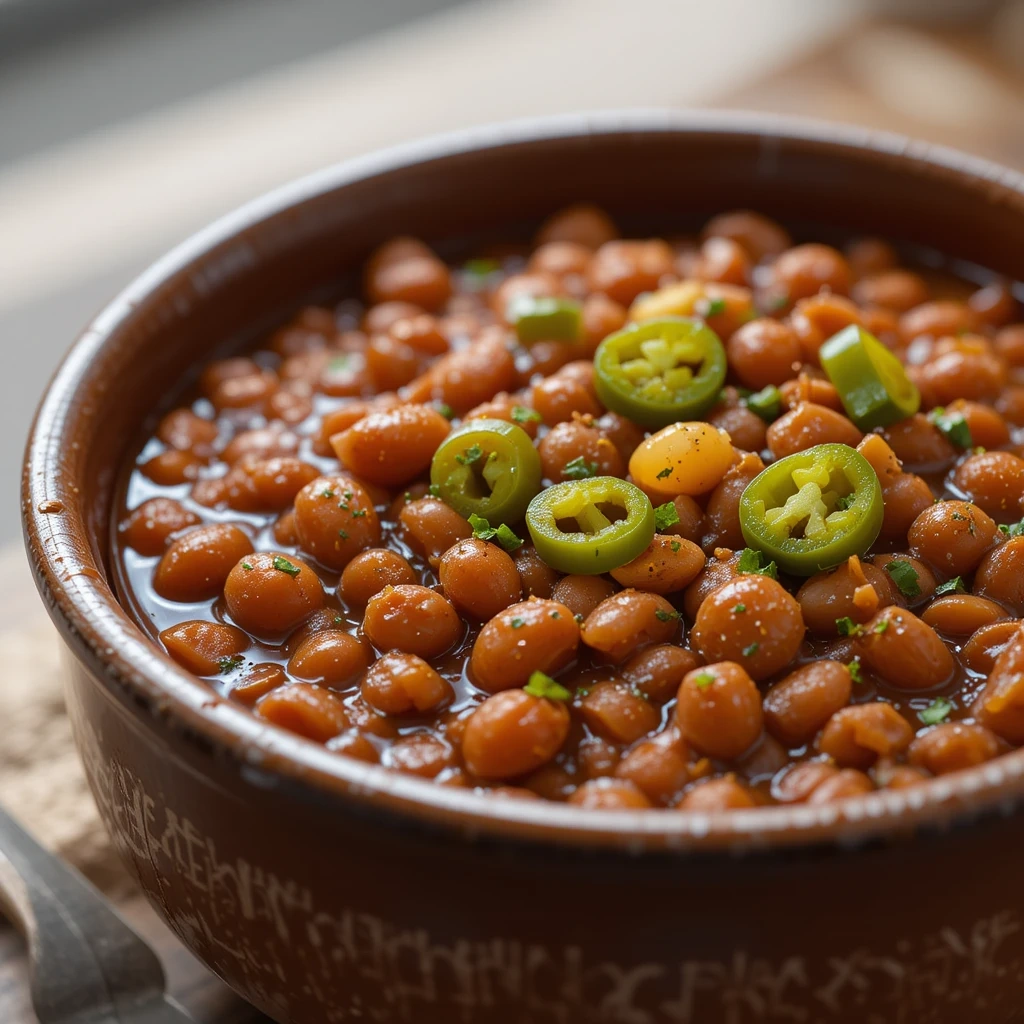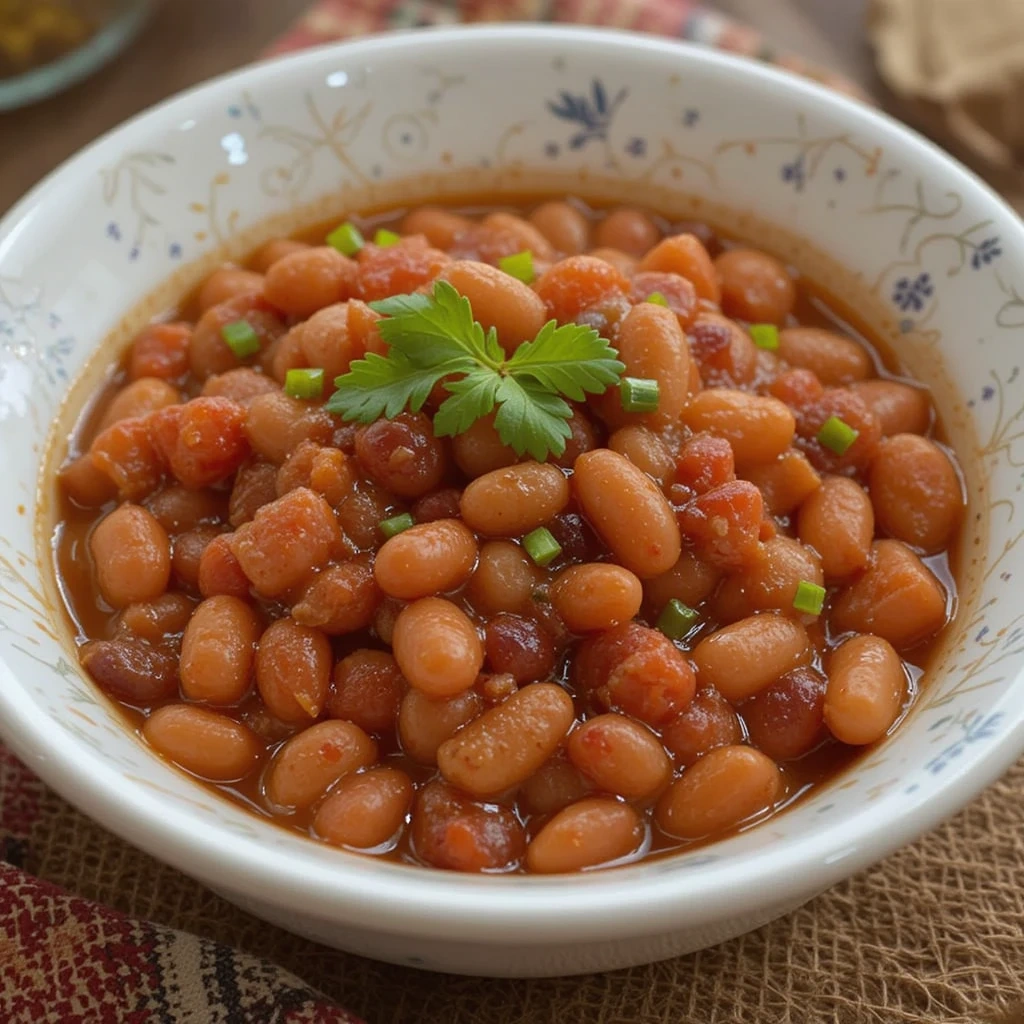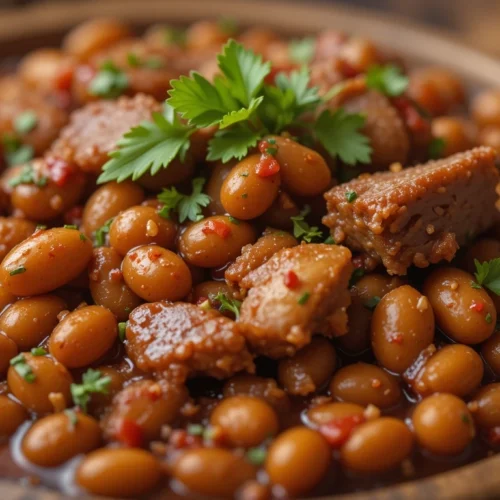Comfort food often brings to mind classic baked beans, a dish that carries a sense of nostalgia with its rich, sweet, and savory flavors, reminiscent of family gatherings and summer barbecues. A simple base of navy beans, molasses, brown sugar, and a hint of mustard creates a luscious sauce that clings to each bean, offering a delightful experience in every bite. The beans are soaked overnight to soften them and enhance their flavor, then simmered with onions, garlic, and spices before baking slowly in the oven to allow the flavors to meld. This dish, often served alongside grilled meats or cornbread, evokes cherished family moments, making it a beloved recipe.
When I think of comfort food, classic baked beans immediately come to mind. There’s something so nostalgic about the rich, sweet, and savory flavors that remind me of family gatherings and summer barbecues. My grandmother had a recipe that was passed down through generations, and I can still picture her stirring the pot on the stove, the aroma wafting through the house.
The base of this dish is simple: navy beans, molasses, brown sugar, and a hint of mustard. The combination creates a luscious sauce that clings to each bean, making every bite a delightful experience. To make this classic dish, I usually start by soaking the beans overnight.
This step not only softens them but also enhances their flavor. After draining and rinsing, I simmer them with a mixture of onions, garlic, and spices before adding the sweet and tangy sauce. The key is to let them bake slowly in the oven, allowing the flavors to meld beautifully.
I often serve these beans alongside grilled meats or cornbread, and they never fail to impress my guests. Each spoonful transports me back to those cherished family moments, making it a recipe I hold dear.
Table of Contents
Spicy Baked Beans with a Kick
The Birth of a Flavorful Idea
I still remember the summer cookout where I first decided to add jalapeños to my baked beans. I wanted to give the traditional recipe a bold and fiery spin, and the result was nothing short of spectacular. The combination of the jalapeños’ heat and the sweetness of the molasses created a perfect balance that left everyone wanting more.
The Secret to Spicy Baked Beans
To make these mouth-numbing baked beans, I start with the classic base and add diced jalapeños and a splash of hot sauce for an extra kick. Sometimes, I also throw in some chipotle powder to give it that smoky flavor that pairs so well with the sweetness. As the beans bake, the spices infuse into the dish, creating a flavor profile that’s bursting with excitement.
A Recipe for Conversation and Laughter
I love serving these spicy baked beans at gatherings because they always spark conversations and laughter as friends try to handle the heat.It is an enjoyable method to enhance a classic dish and introduce an element of excitement to any dining experience.

Sweet and Tangy Baked Beans
Sweet and tangy baked beans are another variation that has become a staple in my kitchen. I recall a potluck where I decided to bring something different from my usual offerings. I wanted to create a dish that would surprise my friends, so I experimented with adding pineapple and apple cider vinegar to my baked beans.
The result was a delightful explosion of flavors that left everyone asking for the recipe. The sweetness from the pineapple complements the savory elements beautifully, while the apple cider vinegar adds just the right amount of tanginess. When preparing this dish, I mix in diced pineapple chunks along with the traditional ingredients, allowing them to caramelize as they bake.
The combination of flavors is truly irresistible! Whenever I serve these sweet and tangy baked beans, they disappear quickly, often leaving me with requests for more. It’s a fun twist that keeps everyone guessing what secret ingredient makes them so special.

Vegetarian Baked Beans with a Twist
| Ingredient | Quantity |
|---|---|
| Beans | 2 cups |
| Tomato sauce | 1 cup |
| Onion | 1 medium |
| Garlic | 2 cloves |
| Maple syrup | 2 tbsp |
| Mustard | 1 tbsp |
| Paprika | 1 tsp |
| Salt | to taste |
As someone who enjoys experimenting with plant-based recipes, vegetarian baked beans have become one of my go-to dishes. I remember hosting a dinner party for some friends who follow a vegetarian diet, and I wanted to create something hearty and satisfying. Instead of using traditional bacon or meat, I decided to incorporate mushrooms and lentils for added texture and flavor.
The earthy taste of mushrooms combined with the protein-packed lentils creates a robust dish that even meat lovers can appreciate. I sauté the mushrooms with onions and garlic before mixing them into the beans, allowing their flavors to meld together beautifully. To add an unexpected twist, I sometimes include a splash of balsamic vinegar or maple syrup for depth.
This vegetarian version has become a favorite among my friends; it’s proof that you don’t need meat to create a filling and delicious meal.
Add a touch of comfort to your meal with the Simple Baked Beans II recipe from Allrecipes. This quick and flavorful dish combines canned baked beans with crispy bacon, sautéed onions, brown sugar, ketchup, and mustard, all simmered together to create a rich and savory side. Ready in just 30 minutes, it’s an ideal accompaniment to hearty main courses like chicken tortellini.Allrecipes

Smoky Baked Beans for a Flavorful Twist
If you’re looking for a way to add depth to your baked beans, smoky flavors are the way to go. I vividly remember my first attempt at making smoky baked beans during a camping trip with friends. We had a portable grill, and I decided to experiment by adding smoked paprika and liquid smoke to my recipe.
The result was an unforgettable dish that perfectly complemented our grilled meats. To achieve that smoky flavor at home, I recommend using smoked paprika as well as incorporating some diced smoked sausage or bacon if you’re not strictly vegetarian. The combination of these ingredients creates an irresistible aroma as they bake together in the oven.
Each bite is packed with flavor that transports me back to those fun camping nights around the fire. Smoky baked beans have since become a staple in my repertoire; they’re perfect for any gathering or simply as a comforting weeknight meal.
Warm up with the comforting flavors of the Beef Stew Recipe from Veibrant Recipes. This hearty dish features tender chunks of beef simmered in a rich, savory broth alongside a medley of vegetables, creating a satisfying meal perfect for chilly evenings. The recipe provides step-by-step instructions to guide you through the cooking process, ensuring a delicious and nourishing stew that can be enjoyed by the whole family.
Baked Beans with Bacon for a Hearty Dish
A Family Favorite
Growing up, my family would often make baked beans with bacon on chilly winter evenings when we craved something warm and filling. The addition of crispy bacon elevates the dish to new heights, adding richness and depth that’s hard to resist.
The Secret to Flavorful Beans
When preparing this dish, I like to start by frying up some bacon until it’s nice and crispy before adding it to the bean mixture. The rendered fat from the bacon infuses into the sauce, creating an incredibly flavorful base. As it bakes in the oven, the beans soak up all that deliciousness, resulting in a comforting dish that warms both body and soul.
A Crowd-Pleasing Recipe
Whenever I serve these baked beans with bacon at gatherings, they’re always met with rave reviews—there’s just something about that smoky flavor combined with sweetness that makes it utterly irresistible.
Baked Beans with a Mediterranean Flair
For those looking to explore international flavors, baked beans with a Mediterranean flair is an exciting twist on this classic dish. I remember traveling through Greece and being inspired by their vibrant use of herbs and spices in everyday cooking. When I returned home, I decided to incorporate some of those elements into my baked beans recipe.
To create this Mediterranean version, I use chickpeas instead of traditional navy beans and add ingredients like sun-dried tomatoes, olives, and fresh herbs such as oregano and basil. The result is a unique dish that bursts with flavor and freshness. As it bakes, the herbs infuse into the beans, creating an aromatic experience that transports me back to those sun-soaked days by the Mediterranean Sea.
This variation has become one of my favorites; it’s perfect for serving alongside grilled vegetables or as part of a mezze platter.
5 Common Mistakes to Avoid and Their Solutions
As much as I love cooking baked beans, I’ve learned through trial and error that there are common mistakes that can lead to less-than-perfect results. One mistake I’ve made is not soaking the beans long enough before cooking them. This can lead to tough beans that don’t soften properly during baking.
To avoid this issue, I always soak my beans overnight or at least for several hours before cooking. Another common pitfall is overcooking or undercooking the beans during baking. I’ve had my fair share of burnt edges or mushy textures because I didn’t keep an eye on them in the oven.
To prevent this from happening, I recommend checking on your beans periodically while they bake and adjusting the cooking time as needed based on your oven’s performance. Additionally, not seasoning adequately can lead to bland baked beans—a mistake I’ve made more times than I’d like to admit! Always taste your mixture before baking and adjust seasonings accordingly; sometimes a pinch more salt or spice can make all the difference.
Lastly, using low-quality ingredients can significantly impact flavor; I’ve learned this lesson after trying out cheaper canned beans or sauces that just didn’t cut it. Investing in good-quality ingredients will elevate your dish tremendously! By avoiding these common mistakes and following these solutions, you’ll be well on your way to creating mouthwatering baked beans every time you cook them!
FAQs
What are some variations of baked beans to try?
Consider trying different types of baked beans, such as traditional baked beans or spicy baked beans with a kick. spicy, sweet and tangy baked beans, vegetarian baked beans with a unique flavor, and smokybaked beans for a flavorful twist.
What is the classic baked beans recipe?
The classic baked beans recipe typically includes navy beans, bacon, onion, brown sugar, ketchup, mustard, and molasses. These ingredients are combined and baked in the oven until the beans are tender and the flavors have melded together.
How can I make spicy baked beans with a kick?
To make spicy baked beans with a kick, you can add ingredients such as hot sauce, chili powder, cayenne pepper, or diced jalapenos to the classic baked beans recipe. Modify the spice level according to your taste.
What is the recipe for sweet and tangy baked beans?
To make sweet and tangy baked beans, you can add ingredients such as honey, maple syrup, apple cider vinegar, and Worcestershire sauce to the classic baked beans recipe. These components will infuse the dish with a sweet and tangy taste.
How can I make vegetarian baked beans with a twist?
To make vegetarian baked beans with a twist, you can use ingredients such as black beans, kidney beans, or pinto beans instead of navy beans. You can also add vegetables such as bell peppers, carrots, or mushrooms for added flavor and texture.
What is the recipe for smoky baked beans for a flavorful twist?
To make smoky baked beans, you can add ingredients such as smoked paprika, liquid smoke, or smoked bacon to the classic baked beans recipe. These ingredients will add a rich, smoky flavor to the dish.
How can I make baked beans with bacon for a hearty dish?
To make baked beans with bacon, simply add cooked and crumbled bacon to the classic baked beans recipe. The bacon will add a hearty and savory flavor to the dish.
What is the recipe for baked beans with a Mediterranean flair?
To make baked beans with a Mediterranean flair, you can add ingredients such as olives, sun-dried tomatoes, feta cheese, and Mediterranean herbs such as oregano and thyme to the classic baked beans recipe. These ingredients will add a Mediterranean twist to the dish.
What are some common mistakes to avoid when making baked beans?
Some common mistakes to avoid when making baked beans include overcooking the beans, using too much or too little liquid, not seasoning the beans adequately, using the wrong type of beans, and not allowing the flavors to meld together.

baked beans recipe
Ingredients
- Pros: Use only for editorial reviews related to your recipe
- Easy to make
- Can be made ahead of time
- Great for crowds
- Versatile; can be customized to your taste
- Cons: Use only for editorial reviews related to your recipe
- Long cooking time
- Requires overnight soaking of beans optional, but recommended
Instructions
- Regarding the image requests, since the attached file couldn’t be accessed, I cannot provide specific image descriptions based on its content. Instead, I can offer general descriptions for similar images:
- Realistic image of this exact woman loading a plate of sweets into the kitchen: A middle-aged woman with a warm smile is carefully carrying a plate piled high with colorful cookies and pastries into a brightly lit, homey kitchen. Sunlight streams through a nearby window, illuminating the delicious treats.
- Cutting vegetables in the kitchen: A close-up shot shows hands expertly chopping fresh vegetables on a wooden cutting board in a well-equipped kitchen. The vibrant colors of the vegetables (e.g., red bell pepper, green zucchini, yellow onion) stand out against the warm tones of the wood.

